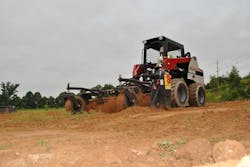How to Keep Hydraulics Clean
Much like today’s high-pressure common-rail Tier 4-F diesel engines, the latest hydraulic systems are highly sensitive to contamination—even the smallest contaminants can cause big trouble.
Here are some helpful tips on hydraulic system maintenance from skid steer, CTL, and compact excavator specialist Takeuchi.
First, it’s important to be proactive by performing regular maintenance for everything from filters to fluid testing.
Daily routine:
- Check fluid levels
- Look for damaged lines, cylinders, and hydraulic leaks around the machine
- Clean hydraulic attachment couplers before connecting to the machine
- Pay attention to hydraulic oil temperatures especially when running high-flow attachments, such as a mulching head.
Annual maintenance:
- Take fluid samples to ensure hydraulic oil and vital components are at acceptable particle levels
- Always replenish with manufacturers’ recommended hydraulic fluid.
Other intervals:
- Manufacturers have a new machine break-in period around the first 50 hours of operation. Follow scheduled (hourly) maintenance for replacement of filters and hydraulic oil.
In addition to routine maintenance, Takeuchi stresses that cleanliness is also important when swapping out attachments. Keep dirt and other contaminates from getting into the system by cleaning attachment fittings on both the machine and attachment side before connecting. Clean the refill cap and surrounding area before replenishing hydraulic fluid.
Takeuchi also recommends connecting only new hydraulic attachments to a machine, or attachments that are already in your lineup. Otherwise, it may introduce contaminated oil into your machine’s system from an unfamiliar attachment—unless you’re willing to take the time to test the hydraulic fluid already stored in the attachment, you should be aware of the potential consequences.
The hydraulics system is the backbone and hardest working part of the machine. Damaging it can render an excavator, CTL, or skid steer useless.
Not only will damage or neglect cost downtime on the job, but it will also cost thousands of dollars down the road. Make a plan to protect the most expensive and vital components of your machine.
